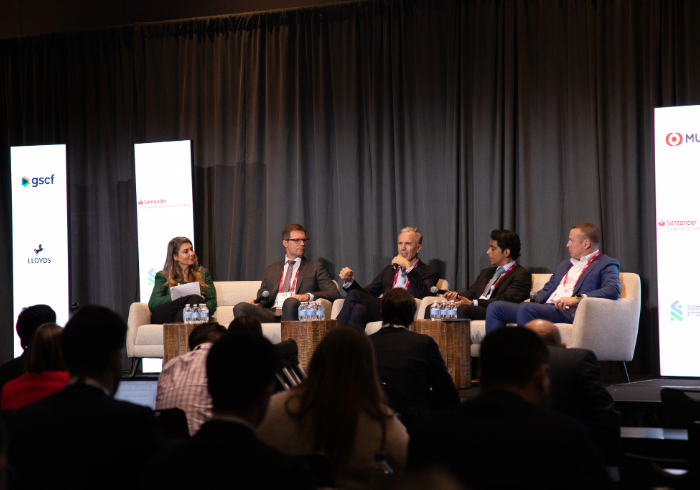Although anticipated, the trade war that began in early 2025 has still stunned observers with its scale and unexpected twists. As this uncertain context weighs on international trade, Emmanuelle Petelle, deputy head of trade services at Societe Generale, assesses the stakes and challenges for trade finance over the coming months.
The decisions of the US administration regarding tariffs have already had tangible consequences for international trade.
The World Trade Organization has significantly revised its outlook for 2025: while it initially projected a 2.7% growth in global merchandise trade for 2025, it now anticipates a decline between 0.2% and 1.5%, depending on the extent of the applied tariff measures. This is an unprecedented setback.
North America is expected to be the most affected region this year, with a projected drop of 12.6% in exports and 9.6% in imports, while growth is expected to be very moderate in Europe (+1.0% for exports and +1.9% for imports) and Asia (+1.6% for both exports and imports).
An unstable and uncertain climate, less conducive to trade
At Societe Generale, we have not yet seen clients cancel existing contracts or withdraw the mandates they have entrusted to us for the issuance of trade finance instruments, such as letters of credit, standby letters of credit, guarantees and short-term financing. However, we are already observing a slowdown in the initiation of new short-term transactions (ranging from one to six months) amongst banks.
More than the tariffs themselves, it is the instability that constitutes the primary concern for clients.
The almost daily announcements and bilateral negotiations create a climate of uncertainty that is not conducive to investment, while also eroding the trust between countries.
These concerns are clearly reflected in a study conducted by the International Chamber of Commerce (ICC) last April. It found that the increase in costs worries 64% of the surveyed companies, followed by uncertainties regarding planning (47%) and disruptions in supply chains (45%).
Towards a reorganisation of trade corridors
The most significant impact of this new geopolitical context is likely to be felt next year, when companies will have finalised their revisions of investment decisions, budgets and forecasts, and when tariffs with the US are more stabilised.
Certain sectors, such as automotive, electronics, agribusiness and materials for renewable energy projects – particularly affected by threats of high tariffs on solar panels from Southeast Asia – will be more impacted than others. However, considering uncertainties regarding interest rates, exchange rates and export volumes, all companies are currently in a phase of re-evaluating their commercial and financial indicators, as well as their strategies.
This new configuration points towards a redefinition of trade corridors. Chinese exporters, for example, will intensify their presence in other markets such as Europe, the Middle East, Africa and Asia. India, with its skilled workforce and competitive costs, could thus play a major role in the reshaping of global trade. Attempts to circumvent tariffs through third countries are also anticipated. Meanwhile, some nations may benefit from this situation through shifts in flows and production over the coming quarters and years.
Despite the uncertainty, the trade war is accelerating several underlying trends – chief among them, the push by Europe and the US to reindustrialise. Strategic sectors for investment include battery production, IT infrastructure (including data centres and cloud services) and aerospace and defence sectors.
At the same time, while the development of renewable energies and decarbonisation projects is not fundamentally called into question, progress could be slowed by rising tariffs on Chinese metals and semi-finished goods, which are driving up project costs.
Clearly, to cope with uncertainties and changing investment priorities, companies will need liquidity. The impact will be felt in working capital requirements to finance inventories and the purchase of key components at higher prices due to rising tariffs, alongside a growing need to diversify raw material supplies and avoid overreliance on a single country. We already have many financing solutions: short-term loans, letters of credit, import/export guarantees, supply chain finance and receivables discounting.
In this new context, these classic instruments remain entirely relevant and adequate. But to clarify: with the implementation of the Basel III reform, banking institutions now have somewhat less leeway than in the past. They must comply with increased capital requirements while facing growing regulatory demands (capital reporting, ESG data, anti-money laundering, etc), which weighs on credit capacity, operational costs and hence on overall bank profitability.
An opportunity to accelerate the digitalisation of trade finance
This situation should prompt all trade finance players to accelerate the digitalisation and streamlining of processes,3 aiming to boost efficiency while managing cost increases linked to new regulatory requirements. France has already made significant progress on this front, with the support of the Ministry of Finance. However, the Model Law on Electronic Transferable Records (MLETR) adopted by the United Nations Commission on International Trade Law (UNCITRAL) in 2017, has only been transposed in about 10 countries to date.
Fortunately, some topics are progressing faster than others: this is the case for the digitalisation of instruments involving fewer actors, such as bank guarantees, which only require three stakeholders (applicant, beneficiary and bank).
Societe Generale is actively involved in the drive to digitalise trade financing (letters of credit, forfaiting). Since its inception, we have supported the ICC-Paris Europlace initiative to accelerate the adoption of digital solutions in France. Societe Generale contributes actively to the working groups established by the initiative, particularly within the advocacy pillar, promoting dialogue among stakeholders across the entire trade community. Efforts are underway to develop several proofs of concept with clients from both commodity and non-commodity sectors, along with their banking counterparts worldwide, to assess the practical applicability of various tools and platforms.
To accelerate the movement globally, efforts to educate states and various stakeholders on this topic must intensify, to better explain to regulators how the digitalisation of instruments contributes to the fluidity and security of international trade. This issue is more relevant than ever before.








